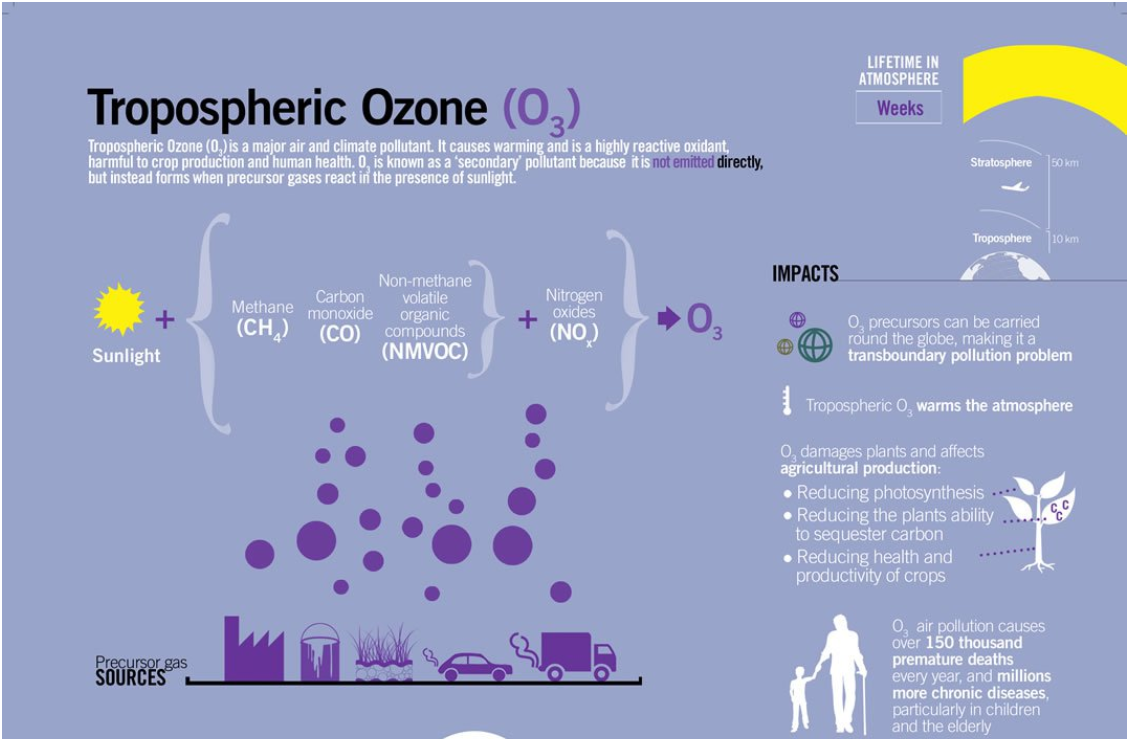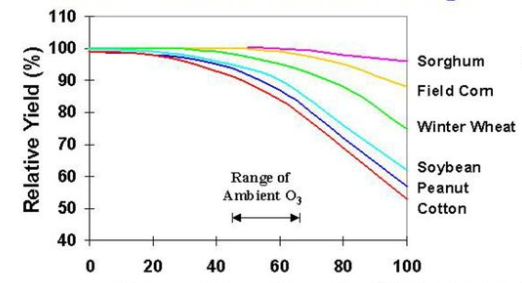
Indian Agriculture Needs an Ozone Pollution Mitigation Strategy
A recent study published in the Journal Science Advances has raised alarm bells by stating that the Indian coastline and the Himalayan region
are at a high risk of Ozone pollution by 2100. This exposure to ozone pollution has the potential to deliver a decisive blow to efforts made by conservationists to protect the biodiversity in the Indian Coastline and the Himalayan regions. Additionally, exposure of ozone pollution, if not tackled, can have a deleterious impact on national food security by 2050.
Ozone is found in two different layers in the earth’s atmosphere namely the stratosphere and troposphere. The Stratosphere is composed of naturally occurring ozone molecules which protect the Earth’s surface from harmful ultraviolet radiation. Stratospheric ozone is therefore termed ‘good ozone’. On the other hand, ozone molecules present in the troposphere, i.e. the layer nearest to the ground, are termed as ‘bad ozone’ because it is a secondary pollutant produced as a result of photochemical interaction between incoming solar radiation and primary pollutants such as nitrogen oxides, volatile organic compounds, carbon monoxide, or methane. A high concentration of bad ozone is one of the most impactful air pollutants that adversely affects vegetation. On the other hand, Fuhrer, Van Dingenen, Metaxoglou and Smith have shown that a decrease in ground level ozone concentration has had positive impacts on crop yields in the United States. The authors studied the impact of reduction in the number of coal fired plants on agricultural production. Coal fired power plants emit nitrogen oxides, a precursor of surface ozone (bad ozone), reduction in their number led to dramatic reduction in the emission of nitrogen oxide which in turn decreased the formation of bad ozone in the surrounding atmosphere. This boosted agricultural production of soybean and corn in the surrounding areas.

Figure 1| Tropospheric ozone precursors, sources, formation and effects (image source: Climate & Clean Air Coalition - Tropospheric Ozone)
However, in the world as a whole the scrooge of Surface ozone has hit a purple patch. Surface Ozone concentration has increased from 10 parts per billion (ppb) to 50 ppb in the summer since pre-industrial era. Its growing presence in the atmosphere and its notorious distinction of being a major air pollutant has caught the attention of a nervous global community. Further investigation into the source of this problem has revealed that precursors of such ozone are emitted from industrial, transport and other anthropogenic activities. Some effluents released from these activities form ozone in presence of sunlight. To further compound the problem, it has been found that these ozone molecules easily transport over long distances. Thus, the negative effects of bad ozone will be felt even in far off rural areas. Research has exemplified this hypothesis by proving the existence of high levels of tropospheric ozone concentration in agrarian regions.
This ozone stress induces reduction in photosynthetic proteins, impairs reproductive development, accelerates leaf senescence and induces metabolic pathways resulting in reduced yields and altered crop quality. In essence, ozone molecules enter plants through stomatal pores. Upon entering, they generate reactive oxygen species (ROS) and cause oxidative stress. As a result, it triggers an antioxidant defense system which plays a decisive role in maintaining ROS levels and cellular redox balance. The antioxidant defense system varies according to plant type. Different plants have different ozone thresholds. The threshold for rice is 41 ppb while for wheat is 25ppb. The presence of Ozone in excess of this threshold sabotages a plant’s internal deterrence and negatively impacts its productivity. Thus, increasing surface ozone concentration can torpedo measures to attain global food security by reducing photosynthetic activity in crops. Globally, different assessments are undertaken to understand the impacts of ground level ozone on crops. Some studies even date back to the year as early as 1969 and since then various studies have been conducted to understand the impacts of ozone on crop yield owing to rising ground level ozone concentration. McGrath in Metaxoglou and Smith suggests that during the period 1980-2011, ozone exposure reduced corn yields by 8.0% to 11.6% and soybeans by 3.3% to 7.7%. Another current analysis suggests that when crops are exposed to 30-60 ppb ozone concentration, yield declines by 17.5% for rice and 9.7% for wheat and predicts such decline to further increase by 10% when exposed to 51-75 ppb ozone.
India in particular needs to pay attention as its location on the globe makes it a ripe target. Ozone concentration in the atmosphere is directly proportional to temperature. Some observers have concluded that such concentrations peak during the summer season since surface ozone forms in the presence of sunlight. However, tropical countries experience prolonged stomatal ozone fluxes as they have relatively high temperatures throughout the year. India as a result has favourable conditions for formation of surface ozone because of large volumes of anthropogenic emissions and relatively high solar intensity. Rice is the major kharif crop and wheat is the major rabi crop of the country. Surface ozone levels analysed during both these seasons often exceed 40 ppb threshold. Hence, surface ozone pollution is a threat to agriculture throughout the year in India.
However, non-tropical countries cannot afford to heave a sigh of relief either. Analysis of stomatal ozone flux in seasons apart from the summer season has become necessary even for non-tropical countries owing to climate change and constant increase in global temperatures. This is important as the increase in spring and autumn temperatures would create conditions closer to the optimum for ozone conductance. This might cause prolonged stomatal ozone fluxes. This prolonged stomatal ozone flux would defy current conventional wisdom in which crops grown in early spring and autumn are not considered to be at risk from ozone pollution. Considering current air quality legislation, estimates are that global ozone levels will increase by 1.5 ± 1.2 ppb on average by 2030.

Figure 2|Effect of surface ozone concentration on crop yield: Dose-response functions have been established to understand the impacts of ozone concentrations on plants. Accordingly, ozone pollution does not impact crop yield until a specific threshold is achieved for respective crop variety. Beyond that threshold, there is an evident decrease in crop yield. As can be seen in this graph, cotton is the worst affected crop while sorghum is the least affected crop to increasing ozone concentration. When exposed to ozone concentration above 40ppbV (AOT40), relative losses for wheat are 7-12% and 6-16% for soybean.(Data source: Productivity Spillovers from Pollution Reduction)
First in the line of fire are rapidly industrialising developing countries. Such countries as stated earlier enhance emissions of ozone precursors resulting in increased surface ozone concentration. Additionally economies of such developing countries are agriculture-based economies. Loss in agricultural productivity and crop yield because of ozone pollution may directly impact their GDP growth. This in turn will further aggravate existing concerns of poverty and hunger. For example, India is an agriculture-based economy with 58% of its population relying on agriculture as a source of livelihood. Present day losses in crop yields of wheat (3.5 ± 0.8 metric tonnes) and rice (2.1 ± 0.8 metric tonnes) because of ozone stress is sufficient to impact India’s ability to feed the 35% of its citizens that live below the poverty line. On the other hand, with increasing trends in ground level ozone concentration, agricultural production losses are estimated to be 50% by 2030. Agricultural losses in value terms are projected to total an unconscionable $14-26 billion in India alone.
Despite the alarming predictions, the battle has not been lost. Research has shown that crop yields respond differently to the concentration of ground level ozone depending upon abiotic stresses. For example, crops grown in areas of high carbon dioxide concentration and irrigated water supply had the lowest yield loss from ozone stress, but the loss was relatively greater when ozone stress was combined with low carbon dioxide concentration and water deficit. This is because exposure to such physiological stresses enhances the impact of ozone concentration on plants which leads to partial closure of stomata facilitating decreased foliar-gas exchange. Thus, abiotic factors play an important role in determining the effect of ozone stress on plants.
Considering a broader picture, it is important to ponder over the consequences of such mounting ozone concentration on future carbon dioxide levels and land under cultivation. Plummeting crop yield may trigger an increase in area under cultivation to ensure global food security. Consequently, according to Chuwah, a 20% decline in crop production may increase area under cultivation by 2.5% which may increase global carbon dioxide concentration by 52.4% in 2050 when compared with carbon dioxide level in 2005. This finding suggests an increase in ground level ozone concentration will have potential effects on enhanced carbon dioxide levels along with repercussions on global food security. Thus, it is thought-provoking that the impact of ozone concentration on vegetation reduces in presence of carbon dioxide while increasing ozone concentration will elevate carbon dioxide levels in future further exacerbating global warming. Nature loves to make us go around in circles.
A 2°C rise in temperature can cause increased stomatal ozone uptake, in crops growing in rabi season, even in absence of further increase in peak ozone concentrations since small changes in background ozone concentration can have widespread impacts on stomatal ozone uptake over the course of growing season. Tropospheric ozone concentration has nearly doubled since 1950, and this concentration is further predicted by Hayes to increase under Representative Concentration Pathway 8.5. Recently, a combination of legislation and modernisation has facilitated a slow increase in ozone concentrations at some sites. As a result, there is significant decrease in peak ozone concentration but increase in background concentration predicts 15% increase in stomatal ozone uptake in 2100 compared to 2010 profiles. This prediction may however vary according to changes in latitude as ozone concentration varies with north-south gradient.
Rapidly developing countries like India need to focus on eco-physiological research activities for efficient analysis of ozone sensitivity within local cultivars to address regional food security. Without significantly cutting down on precursors of surface ozone like nitrogen oxides, India is in for tough times countering its tropospheric ozone pollution. The impact of such pollution would not only impact the crop yield and production but also have a chilling impact on food security, hunger abatement and nutrition. Indian policy makers need to get their act together and prevent incremental annihilation of biodiversity and agricultural hotspots. When it comes to biodiversity and food crops, the policy makers cannot sit back and hope that plants will develop resistance through Mithridatism.
****
Shivani is a Climate Change enthusiast studying at University of East Anglia. She is passionate about environment and wishes to contribute positively to the field of climate change.
Liked the article? Share it on:
Previous Article:
« WHO at the Cusp: Reforms Long Overdue?Next Article:
THE AMERICA I KNEW »